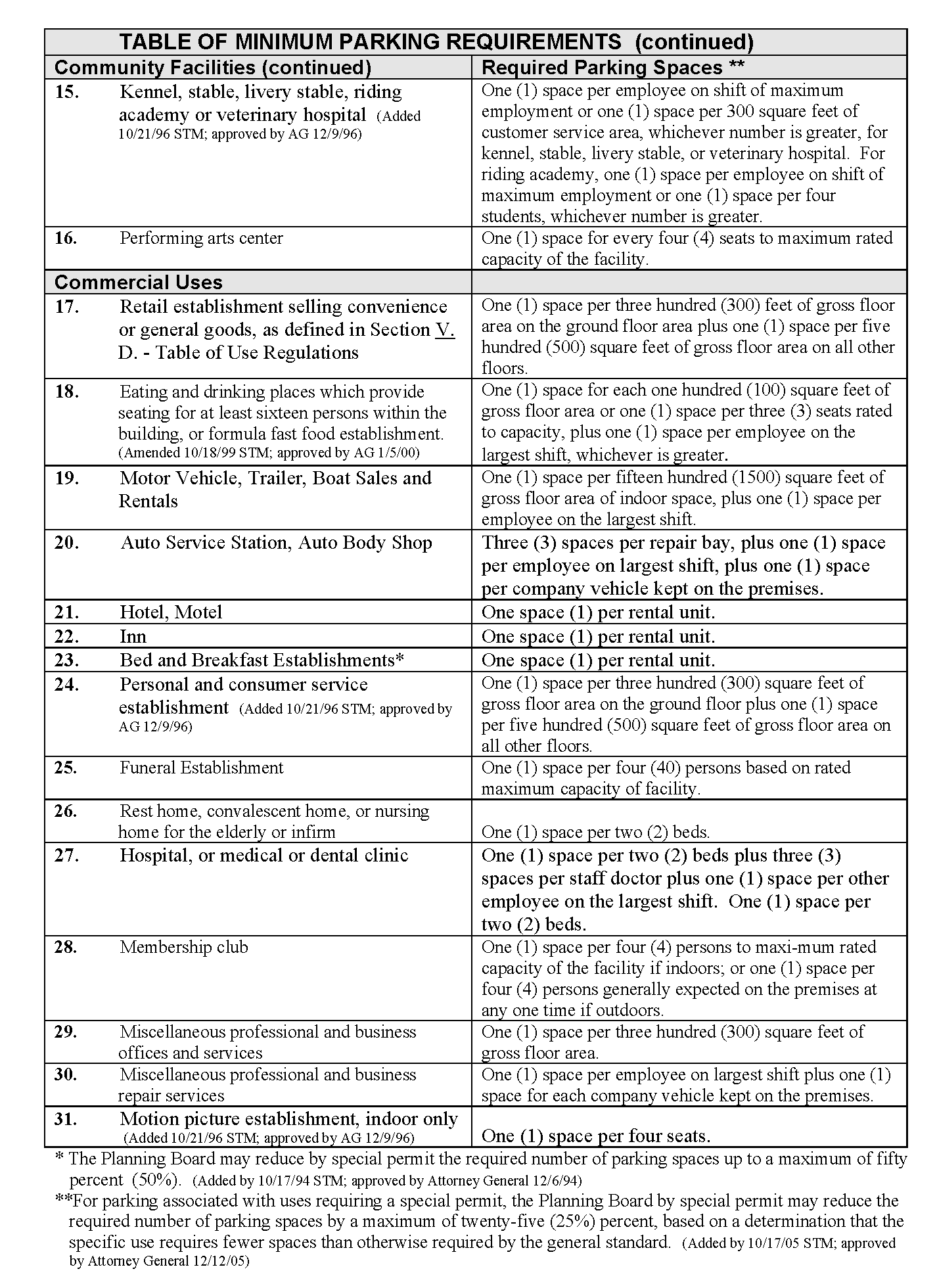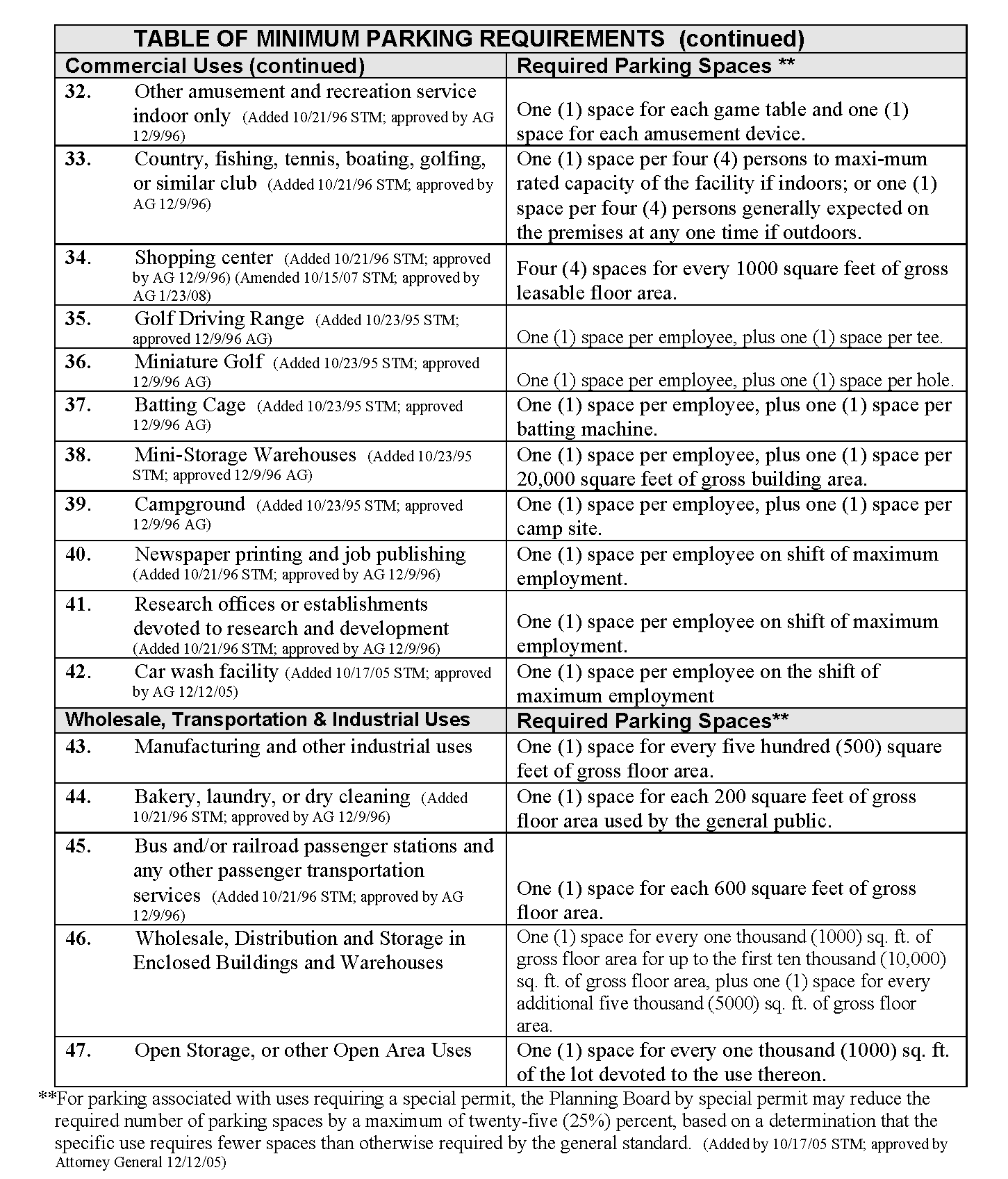�
The purpose of this section is to ensure that all uses are provided with sufficient off-street parking and loading facilities to meet the needs of persons employed at and/or utilizing such uses; to ensure that off-street parking and loading facilities are designed so as to reduce hazards to pedestrians and drivers; to reduce congestion in the streets; to reduce nuisance to abutters from noise, fumes and headlight glare; and to reduce environmental deterioration to surrounding neighborhoods resulting from glare, heat, dust, accelerated storm water run-off, and unattractive views.�
Total automobile storage or parking space per principal use shall be provided in accordance with the formulae set forth in the following Table of Minimum Parking Requirements herein below:�



Where a structure is enlarged or a change in an existing use occurs, only the additional parking spaces required need comply with these formulae.�
No parking space shall be used for any activity which interferes with its availability to meet the minimum applicable parking requirement. Accessory uses are permitted and may include, but not be limited to, necessary traffic directional signs not exceeding two (2) square feet each in area, lighting fixtures for illuminating the parking area, and landscaping within buffer areas.�
By special permit of the Zoning Board of Appeals, joint use may be made of required parking spaces by intermittent use establishments such as churches, assembly halls, or theaters, whose peak parking demand does not conflict with that of the other use. An agreement shall be made in writing and acknowledged by the owner(s) of the uses involved concerning: the number of spaces involved; substantiation of the fact that such joint use is not overlapping or in conflict; and the duration of the agreement. The agreement must be presented with the petition for special permit.�
If the computation of required parking spaces results in a fractional number, only the fraction of one-half or more shall be counted as one.�
Buildings or lots, which contain more than one principal use, are considered Mixed Use facilities. For the purposes of determining parking requirements for such a facility, each use component shall be counted as a separate principal use.�
All required parking or loading spaces shall be provided on the same lot as the use or building for which they are required; provided, however, that if sufficient spaces are unavailable on that lot, the Zoning Board of Appeals may authorize by special permit an alternative location for non-residential parking subject to the following provisions:�
1 .The lot to be utilized for parking shall be in the same legal ownership as the lot served either by deed, by easement, or by long-term lease, no less than thirty (30) years in duration. If the lot is leased, the terms of the lease shall be subject to the Zoning Board of Appeal's approval as to form and duration. Such deed, easement, or notice of lease shall be recorded at the Registry of Deeds, and a copy of the same as recorded shall be filed with and made part of the application for any building or occupancy permit.�
2. The linear distance between the use or building lot and its parking lot shall not be more than three hundred (300) feet.�
3. The separate parking lot shall not create unreasonable traffic congestion or create a hazard to pedestrians being served by the parking lot.�
4.The parking lot shall be properly zoned for the same or a less restrictive use as the principal lot being served by the parking lot. Provided, however, in the case of lots situated in more than one district, not more than twenty (20) percent [or ten (10) spaces, whichever is the lesser] of the parking and loading spaces required for the use of the less restrictively zoned portion of the lot may be located in the more restrictively zoned portion of the lot, so long as the parking and loading spaces and any necessary drives or other paved areas do not extend more than fifty (50) feet into the more restrictively zoned parcel, and all other setbacks, screening, dimensional, density, and other requirements of this bylaw are complied with. (Amended by 10/18/93 Special Town Meeting; approved by Attorney General 2/3/94)�
Business uses need not provide off-street parking if they are located in the Central Business District or within 500 feet of either the municipally-owned parking spaces in the Market Street Parking Lot (identified as all or part of Lots #226, #228 and #235 on Assessor's Map 42A and Lot #298A on Assessor's Map 41B), or the Elm Street/South Main Street Municipal Parking Lot (identified as all or part of Lots #111, #113 and #114 on Assessor's Map 42A). (Amended by 10/20/03 Special Town Meeting; approved by Attorney General 1/22/04)�
Minimum off-street loading requirements shall be required in accordance with the formulae set forth below for every new structure, new use, enlargement of an existing structure and/or change in an existing use. Where the structure is enlarged and/or there is a change in the existing use, the formulae shall apply only to the enlargement and/or change.�
Off-street loading areas shall be provided in accordance with the TABLE OF LOADING REQUIREMENTS as outlined below:�

* The Planning Board may approve by special permit an alternative to the above required number of loading spaces. (Amended by 10/18/04 Special Town Meeting; approved by Attorney General 1/27/05)�
The minimum dimensions of parking spaces and maneuvering aisles for all uses except detached single family and two family dwelling units on their own separate lots, shall be as follows: (Amended by 10/15/01 Special Town Meeting; approved by Attorney General 2/19/02)�

**End spaces, restricted on one of the long sides by curbs, walls, fences, or other similar obstructions, shall have a minimum width of ten (10) feet, and maneuvering space at the aisle end of at least five (5) feet in depth and nine (9) feet in width.�
***May include no more than two (2) feet of landscaped island or setback area at the front of the space, provided there are not obstructions to the vehicle's bumper overhang and provided, further, that the bumper overhang does not interfere with the availability of the island or setback area for snow storage.�
For parking facilities developed in conjunction with a development requiring site plan approval or a special permit, the Planning Board by special permit may reduce the above required dimensions up to a maximum of twenty-five percent (25%), based on a determination that the special circumstances of the development permit a lesser standard than otherwise required. The Planning Board may also allow, by special permit, small car parking spaces (8 feet by 16 feet) to be substituted for up to thirty percent of the standard parking spaces. Compact parking spaces shall be designated by clearly visible signs. (Added by 10/18/04 Special Town Meeting; approved by Attorney General 1/27/05)�
Each loading space shall be at least twelve (12) feet in width by sixty (60) feet in length, and shall be provided with a fourteen (14) foot high clearance. This space shall be exclusive of drives, aisles, or maneuvering space.�
1. Circulation Driveways and parking areas shall be designed with due regard to topography, integration with surrounding streets, general interior circulation and separation of pedestrian and vehicular traffic to reduce hazards to pedestrians and motorists.�
2. Layout Required parking and loading facilities shall be laid out so that each vehicle may proceed to and from its parking space without requiring the movement of any other vehicle. The Board may waive this requirement for parking facilities under full-time attendant supervision.�
In no case shall parking or loading spaces be located so as to require the backing or maneuvering of a vehicle onto a sidewalk or onto a public way in order to enter or leave the space.�
3. In no case shall surface parking or loading spaces be located less than ten (10) feet from any side or rear lot line excluding corner lots, as provided for under paragraph #4 below. (Amended by 10/17/05 STM; approved by Attorney General 12/12/05)�
4. No parking of motor vehicles or driveway serving a parking or loading facility shall be located within thirty (30) feet of an intersection of two street lines.�
5.Except in the Industrial, Limited Industrial, and Highway Business District, no off-street parking facility shall be located within the front setback. However, in the Highway Business (HB) District, the number of off-street parking spaces allowed in the front yard setback shall not exceed fifty (50) percent of the total off-street parking spaces required by this bylaw. (Amended by 10/23/95 Special Town Meeting; approved 1/29/96 Attorney General) Additionally, within the Limited Industrial District, no parking facilities shall be located within the required 50 foot landscaped setback from Route One. Further, within the Planned Commercial District, no parking facilities shall be allowed within the required twenty (20) foot landscaped setback from Route One; however, a maximum of fifteen percent (15%) of the total number of required parking spaces of a lot may be located within the remaining portion of the minimum setback from Route One not subject to landscape requirements. Also, except as noted above in this section, in the Planned Commercial, Limited Industrial and Rural Residence C Districts, in no instance shall any parking or loading be allowed in any of the minimum setback requirements or required open space. (Amended by 10/17/92 Special Town Meeting; approved by Attorney General 1/11/93; further amended by 10/18/93 Special Town Meeting; approved by Attorney General 2/3/94)�
�
Parking facilities shall provide specially designed parking spaces for the physically handicapped in accordance with the Rules and Regulations of the Architectural Access Board of the Commonwealth of Massachusetts Department of Public Safety.�
Handicapped spaces shall be clearly identified by signs indicating that the spaces are reserved for physically handicapped persons. Such spaces shall be located nearest to the handicapped entrance to the use or building served.�
All parking facilities shall be graded, surfaced with non-erosive material, and drained in an adequate manner to prevent nuisance of erosion or excessive water flow across public ways or abutting properties. (Amended by 10/15/07 STM; approved by Attorney General 1/23/08)�
Entrance and exit driveways shall be defined clearly with curbing, signs, and pavement markings. Parking and loading spaces shall be marked clearly in accordance with dimensions specified in subsections J, K, and M above.�
In order to separate parking areas from abutting streets, to provide areas for disposal of snow, and to provide visual relief from expanses of pavement and vehicles, landscaping shall be provided in all parking areas containing ten (10) or more parking spaces. Said landscaping shall include the establishment of vegetative or structural buffers on the perimeter of all parking areas to prevent direct views of parked vehicles from streets and sidewalks, avoid spillover light, glare, noise, or exhaust fumes onto adjacent properties, and to provide the parking area with a reasonable measure of shade when trees reach maturity. Vegetative or structural buffers shall be no less than five (5) feet high. Buffers may be a hedge, wall, fence, berm or combination of these choices. The height of any buffer shall decrease where driveways approach sidewalks, walking paths, and streets in order to provide adequate visibility of pedestrians from motor vehicles and to maintain a clear line of sight for vehicles entering the roadway. Landscaping shall be subject to the reasonable approval of the Planning Board, for all projects which require Site Plan Review approval or a Planning Board Special Permit. (Added by 10/18/04 Special Town Meeting; approved by Attorney General 1/27/05)�
All lighting within parking areas shall be arranged so as to prevent direct glare upon any public way or upon any other abutting property. Lighting shall be provided, where desirable, to improve safety and visibility of the lot.�
�
Parking and loading facilities and landscaping shall be continuously maintained in good condition to ensure continued compliance with the provisions of this section. (Entire section amended by 10/22/90 Special Town Meeting; approved by Attorney General 1/14/91)�